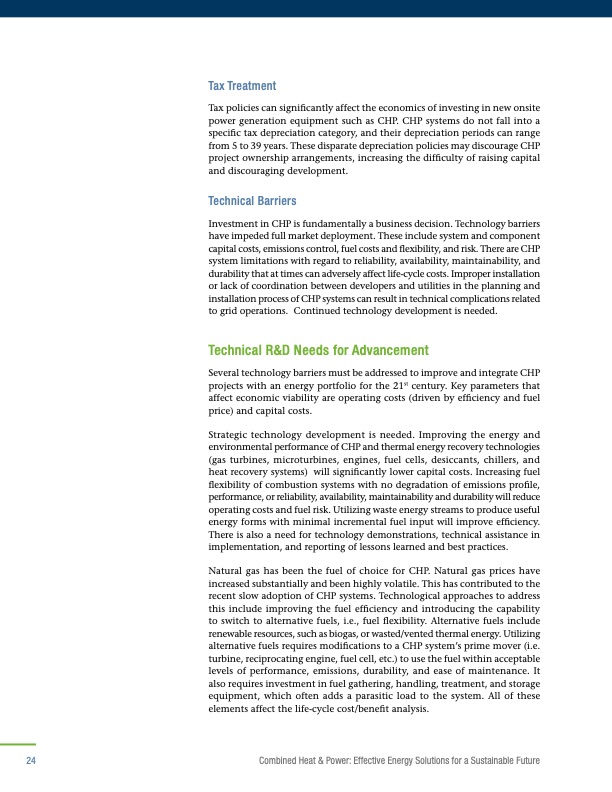
PDF Publication Title:
Text from PDF Page: 028
Tax Treatment Tax policies can significantly affect the economics of investing in new onsite power generation equipment such as CHP. CHP systems do not fall into a specific tax depreciation category, and their depreciation periods can range from 5 to 39 years. These disparate depreciation policies may discourage CHP project ownership arrangements, increasing the difficulty of raising capital and discouraging development. Technical Barriers Investment in CHP is fundamentally a business decision. Technology barriers have impeded full market deployment. These include system and component capital costs, emissions control, fuel costs and flexibility, and risk. There are CHP system limitations with regard to reliability, availability, maintainability, and durability that at times can adversely affect life-cycle costs. Improper installation or lack of coordination between developers and utilities in the planning and installation process of CHP systems can result in technical complications related to grid operations. Continued technology development is needed. Technical R&D Needs for Advancement Several technology barriers must be addressed to improve and integrate CHP projects with an energy portfolio for the 21st century. Key parameters that affect economic viability are operating costs (driven by efficiency and fuel price) and capital costs. Strategic technology development is needed. Improving the energy and environmental performance of CHP and thermal energy recovery technologies (gas turbines, microturbines, engines, fuel cells, desiccants, chillers, and heat recovery systems) will significantly lower capital costs. Increasing fuel flexibility of combustion systems with no degradation of emissions profile, performance, or reliability, availability, maintainability and durability will reduce operating costs and fuel risk. Utilizing waste energy streams to produce useful energy forms with minimal incremental fuel input will improve efficiency. There is also a need for technology demonstrations, technical assistance in implementation, and reporting of lessons learned and best practices. Natural gas has been the fuel of choice for CHP. Natural gas prices have increased substantially and been highly volatile. This has contributed to the recent slow adoption of CHP systems. Technological approaches to address this include improving the fuel efficiency and introducing the capability to switch to alternative fuels, i.e., fuel flexibility. Alternative fuels include renewable resources, such as biogas, or wasted/vented thermal energy. Utilizing alternative fuels requires modifications to a CHP system’s prime mover (i.e. turbine, reciprocating engine, fuel cell, etc.) to use the fuel within acceptable levels of performance, emissions, durability, and ease of maintenance. It also requires investment in fuel gathering, handling, treatment, and storage equipment, which often adds a parasitic load to the system. All of these elements affect the life-cycle cost/benefit analysis. 24 Combined Heat & Power: Effective Energy Solutions for a Sustainable FuturePDF Image | COMBINED HEAT AND POWER 2008

PDF Search Title:
COMBINED HEAT AND POWER 2008Original File Name Searched:
chp_report_12_08_2.pdfDIY PDF Search: Google It | Yahoo | Bing
NFT (Non Fungible Token): Buy our tech, design, development or system NFT and become part of our tech NFT network... More Info
IT XR Project Redstone NFT Available for Sale: NFT for high tech turbine design with one part 3D printed counter-rotating energy turbine. Be part of the future with this NFT. Can be bought and sold but only one design NFT exists. Royalties go to the developer (Infinity) to keep enhancing design and applications... More Info
Infinity Turbine IT XR Project Redstone Design: NFT for sale... NFT for high tech turbine design with one part 3D printed counter-rotating energy turbine. Includes all rights to this turbine design, including license for Fluid Handling Block I and II for the turbine assembly and housing. The NFT includes the blueprints (cad/cam), revenue streams, and all future development of the IT XR Project Redstone... More Info
Infinity Turbine ROT Radial Outflow Turbine 24 Design and Worldwide Rights: NFT for sale... NFT for the ROT 24 energy turbine. Be part of the future with this NFT. This design can be bought and sold but only one design NFT exists. You may manufacture the unit, or get the revenues from its sale from Infinity Turbine. Royalties go to the developer (Infinity) to keep enhancing design and applications... More Info
Infinity Supercritical CO2 10 Liter Extractor Design and Worldwide Rights: The Infinity Supercritical 10L CO2 extractor is for botanical oil extraction, which is rich in terpenes and can produce shelf ready full spectrum oil. With over 5 years of development, this industry leader mature extractor machine has been sold since 2015 and is part of many profitable businesses. The process can also be used for electrowinning, e-waste recycling, and lithium battery recycling, gold mining electronic wastes, precious metals. CO2 can also be used in a reverse fuel cell with nafion to make a gas-to-liquids fuel, such as methanol, ethanol and butanol or ethylene. Supercritical CO2 has also been used for treating nafion to make it more effective catalyst. This NFT is for the purchase of worldwide rights which includes the design. More Info
NFT (Non Fungible Token): Buy our tech, design, development or system NFT and become part of our tech NFT network... More Info
Infinity Turbine Products: Special for this month, any plans are $10,000 for complete Cad/Cam blueprints. License is for one build. Try before you buy a production license. May pay by Bitcoin or other Crypto. Products Page... More Info
| CONTACT TEL: 608-238-6001 Email: greg@infinityturbine.com | RSS | AMP |